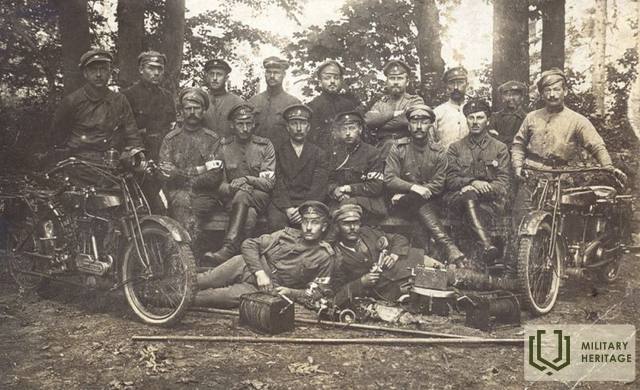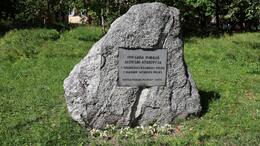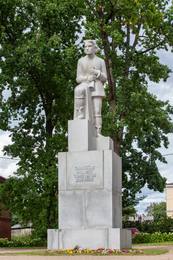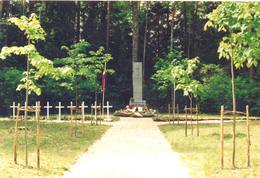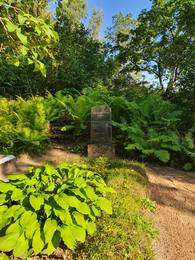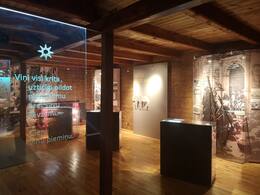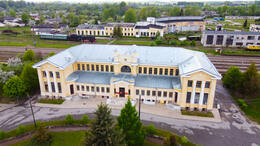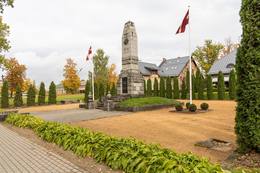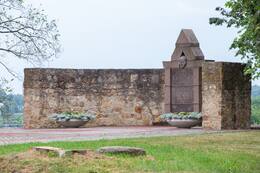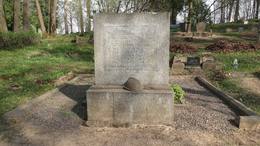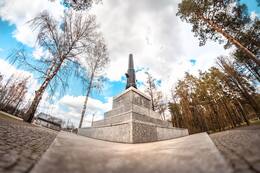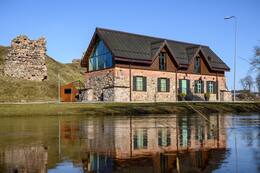1-asis (4-asis) Valmieros pėstininkų pulkas
I Nepriklausomybės karai
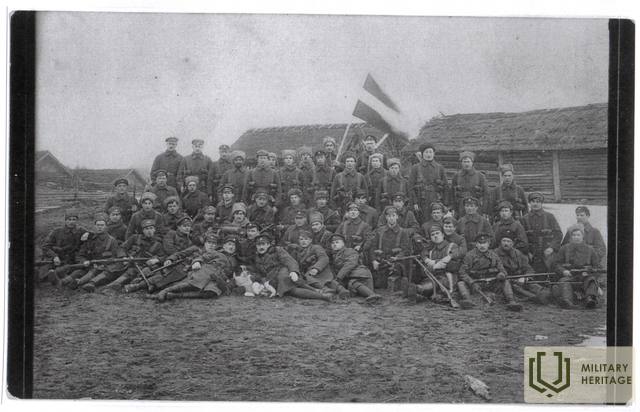
1919 m. vasario 18 d. Taline (Rėvelėje) Latvijos ir Estijos vyriausybių atstovų pasirašytu susitarimu Estijos kariuomenės vadas generolas majoras Johanas Laidoneris įgaliojo suformuoti vieną pėstininkų batalioną ir vieną artilerijos būrį. Formavimo vieta buvo nustatyta Tartu (Tērbatu), kur jau vasario 18 d. pulkininkas leitenantas Jūlijs Jansons pradėjo Latvijos kariuomenės formavimą. Nuo bolševikų išvaduotoje Latvijos šiaurinėje dalyje ir Estijoje buvo paskelbtos Latvijos piliečių mobilizacijos, kurios leido per trumpą laiką suformuoti pulką, kuris buvo pavadintas 1-uoju (latvių) Valmieros pėstininkų pulku.
Kovo 27 d. suformuotas pulkas (800 durtuvų, 5 kulkosvaidžiai, 8 automatai) buvo išsiųstas į Estijos kariuomenės ir Latvijos bolševikų armijos Alūksnės frontą, Apės rajoną, kur po nesėkmingo pirmojo mūšio buvo priverstas trauktis į pradines pozicijas Latvijos Riflės upės 4 krante ginti į Melnupės 4 upės krantą upė. Bajorams traukiantis, pulkas užėmė Apį (27.05.), Vecgulbenę (31.05.), Lubaną ir iki birželio 5 d. pasiekė Krustpilį ir Jēkabpilį. Pulko frontas driekėsi nuo Kaldabrūnės dešiniajame Dauguvos krante iki Balvų. Masinės mobilizacijos metu buvo suformuotas 3-asis batalionas – inžinierių kuopa. Pulko artilerijos baterija dalyvavo Cėsių mūšyje. Po Cėsių mūšio pulkas buvo įtrauktas į Latvijos kariuomenės Vidžemės diviziją ir pervadintas į 4-ąjį Valmieros pėstininkų pulką.
Vasaros pabaigoje pulkas užėmė fronto liniją linijoje Līvāni-Atashiene-Barkava, būdamas nuolatinės kovos veiksmuose prieš bolševikų Raudonąją armiją, tačiau rugsėjo pabaigoje buvo perdislokuotas į Rygą. Nuo 1919 m. spalio mėn. 4-asis Valmieros pėstininkų pulkas, vadovaujamas pulkininko leitenanto Kārlio Bojaro, dalyvavo sumušant Bermonto kariuomenę. Po to Latgaloje kovos su bolševikais tęsėsi iki Nepriklausomybės karo pabaigos. Latvijos nepriklausomybės kare krito 70 pulko karių. Lāčplės karo ordinu apdovanoti 178 pulko kariai.
Po Latvijos nepriklausomybės karo 1920 m. spalį 4-asis Valmieros pėstininkų pulkas buvo perkeltas į Rygą, kur kaip Vidžemės pėstininkų divizijos dalis egzistavo iki Latvijos okupacijos 1940 m., kai buvo įtrauktas į Liaudies armiją.
Daugiau informacijos šaltinių
Valmieros pėstininkų pulko istorija. 1919-1929 m. Ryga, 1929. – p. 465, iš dalies įtrauktas į straipsnių rinkinį: Ziemeļnieki II., 1974. http://www.periodika.lv/periodika2-viewer/view/index-dev.html#panel:pp|issue:/g_001_0306121295|straipsnis:DIVL118|issueT
Valmieros pėstininkų pulkas. Arto Buko istorinis enciklopedinis žodynas. https://vesture.eu/Valmieras_k%C4%81jnieku_pulks
Susijusios vietos
Memorial stone to the liberators of Alūksne
Located in Alūksne, at the intersection of Helēnas and Alsviķu streets.
The memorial stone was unveiled on May 29, 1999, the 80th anniversary of the liberation of Alūksne. The stone forging was performed by the sculptor Ainārs Zelčs.
On March 31, 1919, a Northern Latvian brigade was founded in Tartu to liberate Vidzeme and Latgale. The brigade consisted of the combined 1st Valmiera and 2nd Cēsis Infantry Regiment, later also the Northern Latvian Partisan Regiment, two cavalry squadrons and two artillery batteries. On May 26, these forces occupied Valmiera, but on May 27, the 1st Valmiera Infantry Regiment together with the 2nd Estonian Cavalry Regiment attacked in the direction of Alūksne. The Bolsheviks were unable to repel further attacks and on May 29, 1919, Aluksne was liberated.
Paminklas „Talavos trimitininkas“
Located in Rūjiena Center Square.
The three-meter-high image of an ancient Latvian guardian carved in gray Finnish granite, called the “Tālava trumpeter”, is placed on a three-meter-high granite pedestal, but the total height of the monument reaches 7.5 meters. In the initial sketches and models, K. Zemdega had placed a sword in his hands, which was later replaced by a trumpet. The monument was unveiled on August 15, 1937.
This monument reflects the difficult situation in the formation of our country and army, as well as in the assessment of these events. Immediately after the proclamation of the Latvian state, the Red Army invaded and the interim government of Kārlis Ulmanis established a refuge in Liepāja. In February 1919, with the help of the Estonian army, the liberation of Latvia from the north began and the first mobilization took place in the Rūjiena area for the Latvian troops formed in Tartu, which became the Northern Latvian Brigade under the command of Colonel Jorgis Zemitans. The Northern Latvian brigade fought not only against the Bolsheviks, but also against the Landeswehr and Iron Division in the battles of Cēsis. The soldiers of Northern Latvia, mobilized in the vicinity of Rūjiena, also fought in the subsequent battles for the War of Independence. After the war, the main laurels were won by General Jānis Balodis and the Southern Latvian Brigade he commanded, but he often forgot about the Northern Latvian Brigade. The monument to Rūjiena, which was planned in Rūjiena, was built for a long time, and the monument, unveiled in 1937, was officially popularized as a monument to the liberation of Rūjiena and the memory of fallen soldiers, not to mention the beginning of all regiments in Northern Latvia.
The monument is not only a popular sight for Latvian and Estonian tourists, which is to some extent a starting point for visiting several other places of remembrance of the War of Independence in Rūjiena, but "Tālavas taurētājs" is also a stopping place for Estonian and Latvian officials of various levels.
The monument to the liberation and fallen soldiers of Rūjiena, more commonly known as the “trumpet of Tālava”, was included in the list of cultural monuments protected by the state as an art monument of national significance on October 29, 1998 (monument protection registration number 4522).
Karvas Brothers Cemetery
It is located on the side of Alūksne - Ape road near the Eel House, south of Karva, turning to Rezaka.
The monument was unveiled on September 12, 1937. The granite stencil was designed by Oem Dambekalns in Riga in Riga by the architect Vemera Vitand.
In the autumn of 1975, the local communists destroyed the monument. On March 30, 1989, the Alūksne District Council decided to restore the monument, and on April 30, 1989, a temporary wooden memorial in the form of a Latvian tombstone was erected by Jānis Jaunzems, a worker at the State Electrotechnical Factory (VEF). It read: "The monument to the Karvas Brethren will be restored here."
At that time, the adjacent Brothers' Cemetery was also improved.
In 1993, thanks to the initiative of Uldis Veldre, the head of the Alūksne Brothers' Cemetery Committee, the restoration of the memorial site resumed. The new monument was made by Cēsis stonemason brothers Aivars, Austris and Auseklis Kerliņi.
The monument was unveiled on June 11, 1994.
Four soldiers of the 5th Company of the Valmiera Infantry Regiment are buried in the Brothers' Cemetery - Jēkabs Sukse, Pēteris Leitlands, Ernests Puķītis and Gustavs Ozols, who died on April 2, 1919 in the battles at the Eel House. Roberts Grazer, a soldier of the Valmiera Regiment, was buried as the fifth soldier of the Valmiera Regiment in the mid-1930s, and disappeared on March 31, 1919 at the New Manor. Initially, he was buried as an unknown, but later the name was found and carved into the monument. Augusts Dzedons (Ziedons), the fifth soldier who died in the Battle of Eel, was buried in the Apekalns cemetery.
A memorial plaque has been erected at the foot of the monument to Jānis Goldem (1891–1952), a participant in the eel battle in LKOK, who died in the Communist concentration camp in Inta, Komi.
The second memorial plaque, unveiled on August 23, 1992, was erected at one of the wooden crosses and is dedicated to Corporal Peter Janson of the 7th Sigulda Infantry Regiment, who was assassinated by the oncoming communists on July 7, 1941.
Gulbene Old Cemetery Jāņkalniņš
Located in Gulbene Old Cemetery on Miera Street.
In 1934, a memorial stone to the fallen soldiers of the 1st (4th) Valmiera Infantry Regiment was unveiled in Gulbene Old Cemetery in Jāņkalniņa.
Monument and burial place for the soldiers of the 1st (4th) Valmiera Infantry Regiment, who fell in May 1919, liberating Vecgulbene from the Bolsheviks - in the Old Cemetery in Jāņkalniņa. 1934 under the care of the Gulbene guards, a monument was erected, which miraculously (probably due to its deep growth in bushes and weeds) remained undamaged throughout the Soviet era.
Cultural Heritage Centre "Tīnūži Manor"
The Cultural Heritage Centre ‘Tīnūži Manor’ is located in Ogre municipality, Tīnūži village, 7 km from the cities of Ogre and Ikšķile. The first written evidence about the manor dates back to the 16th century. Until the mid-18th century it was considered an economic production unit with small and insignificant buildings. But over time it grew into a large farm. During World War I, battles between the Russian and German armies took place here, and the Latvian Riflemen were also involved. During the War of Independence Tīnūži manor was used as the headquarters and armoured car park of the 1st Valmiera Infantry Regiment of the Latvian Army. In 1932, the manor was given to the Union of the Latvian War Invalids, which provided accommodation and care for war veterans. During World War II (in 1943) the German Army unit FAT 212 was transferred from Estonia to Tīnūži manor. It was a saboteur unit that prepared soldiers to fight the Red Army. Latvian soldiers were also trained in the arts of intelligence gathering, guerrilla warfare tactics and sabotage. The lord house of Tīnūži manor was destroyed when the Red Army was moving towards Riga. Nowadays it is a place with a beautiful landscape and historical buildings on the banks of the Little Jugla River. Exhibits dedicated to historical events, including the ones concerning the Latvian Riflemen, can be seen at the Cultural Heritage Centre ‘Tīnūži manor’.
Gulbene Railway Station
The Gulbene Railway Station is located in the city of Gulbene. During World War I, in 1916 to 1917, the narrow-gauge railway line to Pļaviņas was reconstructed to 1,524 mm width to ensure that it can serve as a connection to the Rīga-Daugavpils line. In addition, a railway line to Ieriķi and to Sita was constructed, thereby establishing a connection with Pytalovo. As a result, Gulbene became a railway hub. The current station building by architect Pēteris Feders was constructed in 1926. During the War of Independence, on 31 May 1919, when Gulbene was liberated from the Bolsheviks, the 1st (4th) Valmiera Infantry Regiment collected a significant number of war trophies here. On 14 June 1941, both civilians and Latvian Army officers arrested in the Litene Summer Camp were deported from the Gulbene Railway Station. As a key hub, it was bombed in the spring of 1944. After the war, it was restored to its original form. An educational and interactive centre named ‘Railway and Steam’ was opened in 2018. Next to the Gulbene station is the company SIA Gulbenes – Alūksnes bānītis, which offers interactive lessons and tours. Visitors have access to the station building and platform, a memorial plaque and a monument to the repressed ones by sculptor Indulis Ranka.
Monument to the fallen heroes of Gulbene parish in Latvia
Located in the historical center of Gulbene, opposite the Gulbene Evangelical Lutheran Church.
Monument to the victims of the riots of 1905, members of the Gulbene congregation who fell in the First World War and the Latvian War of Independence, and the victims of the Maliena tribunal. The monument was designed by E. Ābeltiņš and was unveiled in 1929 in front of the Gulbene Evangelical Lutheran Church. After the Second World War, a five-pointed star was placed on the monument, then - on its foundations - a plaster image of a Soviet soldier was painted in bronze, and a cemetery of fallen Soviet soldiers was erected behind the monument. When the new cemeteries of Soviet soldiers who died in World War II were opened in Spārīte Park in 1969, the remains of the fallen were transported there, but the site of the monument was leveled with the ground. In the autumn of 1989, the foundations of the monument were excavated and the capsule with the text built into them in 1928 was excavated. The monument was restored in 1992 (sculptor O. Feldbergs).
Between December 24, 1918 and May 31, 1919, when the 1st (4th) Valmiera Infantry Regiment liberated Gulbene from the Bolsheviks, the Maliena (Vecgulbene) Revolutionary War Tribunal and Workers' Club were located in the church. It stood out for the severity of its decisions and the high number of death sentences, often for minor offenses, in which 349 cases were investigated and 606 people were charged.
A memorial sculpture can be seen.
Monument to the soldiers who died in the War of Independence
Located in Valka on Varoņu Street next to the Forest Cemetery.
A monument to 30 soldiers of the 1st (4th) Valmiera Infantry Regiment who died in the Latvian War of Independence can be seen.
The monument was unveiled on October 1, 1922. It consists of the figure of an ancient Latvian warrior ("Ancestor") carved in local pink granite, placed on a two-part pedestal made of gray granite. The sketch of the sculptor Emil Melder (Miller) has been chosen for the monument. Along with Melder, the sculptor Wilhelm Trey also participated in the forging of the monument.
It is the first monument of the Latvian War of Independence created by a professional sculptor, as well as the only one in the interwar period, made in the style of modernism, using elements of Cubism.
During the repeated communist occupation in 1951, the sculpture of the monument was demolished, partially damaged and buried. Burials were also leveled.
In 1988, as the centenary of the sculptor E. Melder (1889-1979) approached, the study of his works began.
The restored brothers' cemetery, along with the restored monument, was unveiled on November 11, 1990.
In 2017, eight memorials to the Knights of the Lāčplēsis War Order connected with Valka were erected in the Brothers' Cemetery. They are located on both sides of the monument - on four sides on each side.
Monument "To those who fell for the Fatherland 1918 - 1920."
It is located on the edge of Riga Street, opposite the Krustpils Palace.
In Jēkabpils, on the right bank of the Daugava, the proposal for erecting a monument to the fallen soldiers of the Freedom Struggle for the monument "Fallen for the Fatherland 1918 - 1920" was made by the Krustpils branch of the Latvian Brothers' Graves Committee on June 12, 1923. For the creation of the monument, on November 12, 1923, the Krustpils Parish Board handed over the stone part of the Tsar Alexander II monument at the parish board building, where the monument was installed in honor of the abolition of serfdom, to the disposal of the Fraternal Graves Committee. The Ministry of the Interior of Latvia allowed the Krustpils branch of the Fraternal Graves Committee to collect donations. In total, 2,400 lats were donated, 1,200 were missing. It was hoped to get them from the bazaar and social evening organized on the opening day of the monument.
The project of the monument is entrusted to the architect Aleksanders Birznieks. The architect's plans were to create a monument from local material - dolomite studs. The volume of the monument was formed by two concentric, massive semi-circles of dolomite stud masonry, the outer one on the Daugava side was lower, cut into the shore and formed a terrace. In its center was a fire cross made of red bricks. In the center of the main half-circle, as an altar, granite plates with the text: "Fallen for the Fatherland 1918 - 1920" and depicting the rising sun above the waves of the Daugava, framed by Latvian symbols. The central part of the monument was formed by the mask of the fallen soldier, which was forged by the sculptor V. Trejs. The Acting Commander of the Latgale Artillery Regiment, Lieutenant Colonel Jākobsons, allowed the use of the square on the right bank of the Daugava opposite the Krustpils Castle for the construction of the monument, on the condition that the square remains the property of the Latgale Artillery Regiment.
In 1925, the Krustpils branch of the Latvian Brethren Cemetery Committee concluded a contract with businessman V. Treija from Riga for the construction of a monument in Krustpils. On July 26, 1925, the foundation of the monument was laid. September 27, 1925 is a holy day for Crusaders. The opening of the monument is taking place with its consecration by the Lutheran pastor of Krustpils parish K. Skujiņš. The Minister of War R. Bangerskis, the commander of the Latgale Artillery Regiment, Colonel Kire, General K. Berķis, etc. participate in the construction of the monument.
20th century In the 1950s, the monument "Fallen for the Fatherland 1918 - 1920" was partially destroyed - the upper part was demolished - the mask of ancient Latvian soldiers, smeared inscriptions, destroyed fire cross sign. On the other hand, already at the beginning of the Third Awakening, the activists of the Krustpils branch of the Latvian People's Front (LTF) in the first regional conferences of the LTF wrote in the resolution the demand to restore the monument in Krustpils. Already on November 11, 1989, at the place where the monument was located, a commemoration was held in which the people of Jēkabpils remembered their Lāčplēši.
At the beginning of 1992, the restoration works of the monument were started. Granite pieces of the required size and shape are manufactured at the Cēsis utility company combine. The granite was processed according to the drawings by E. Nīmanis and V. Treikmanis. The technical supervision of the restoration of the monument is carried out by architect Māra Steķe. In Riga, the sculptor Inta Berga cast the bronze details of the monument. All works were financed from Jēkabpils city funding. The renovated monument was consecrated by Modris Plāte, the then-present rector of Jēkabpils and Krustpils Evangelical Lutheran Church, and Jānis Bratuškins, pastor of Jēkabpils Catholic Church, on November 18, 1992.
Opened in Krustpilis on September 27, 1925. The monument was designed by the architect Aleksandar Birzeniek. The inscription "Fallen even for the Fatherland 1918-1920" is carved into the monument. The monument was partially demolished by the Soviet occupation power in 1941, it was completely destroyed around 1950. The monument was renovated on November 18, 1992.
Monument to the soldiers of the 4th Valmiera infantry regiment who fell in the battles of the Liberation of Latvia
It is located in the Kapele cemetery, on the outskirts of the Z part of Krustpils on the right side of the city of Jēkabpils, behind the Krustpils railway station at Zņuņu iela.
The monument is dedicated to the soldiers of the 4th Valmiera Infantry Regiment - Corporal Fridrich Gagnus and the soldiers - Jēkabs Lutcs, Jānis Miķelsons, Mārtiņas Pabērzas, Jānis Statāns and Gustas Līcis, who participated in the liberation of Krustpils and Jēkabpils from the German invaders and died on 26th of 1919. in August, who were laid to rest in a common grave on August 29, 1919.
In 1937, the Latgale Artillery Regiment approached the Fraternal Graves Committee with a request to develop a monument project. The monument was designed by the architect V. Vitand, while the monument was made in the form of a plate by the firm of E. Kuraua. Already on September 30, 1938, with the participation of the participants of the Freedom Struggle, the Krustpils community and the honor guard of the Latgale Artillery Regiment, the monument was consecrated. The monument below the text on the D side originally had a rifle and helmet cast in bronze. They disappeared. In 2006, the missing parts were restored in similar plastic, and on September 2 of the same year, the restored monument was consecrated with the participation of representatives of the city of Valmiera. The words: "We die so that you may live" are inscribed on the monument.
Monument to the Liberation of Livani
The monument is located at the intersection of Fabrikas and Stacias streets, where it was opened on June 9, 1935 by General Rudolfs Bangerskis, honoring the memory of the soldiers who fell in the battles for the liberation of Lebanon in 1919.
Its main element is a 15-ton, vertically placed cannon barrel. In 1958, the Soviet power dismantled the symbol of the freedom of Lebanon, cutting the barrel of the cannon into scrap metal. The inhabitants of the cannon ball remained throughout the Soviet years, and they returned to their previous place after half a century. The idea of restoring the monument was alive in the people all these years. The Līvāni County Council, together with the residents, was actively involved in the restoration of the monument. Public donations were collected, and on October 3, 2004, the restored Livani Liberation Monument was unveiled in its historic location in the city park.
The inscription on the monument: "Soldiers of the Jelgava infantry regiment fell for Latvia near Līvānii and the liberation of the surrounding area in 1919. Soldiers of the former North Latvian partisan regiment."
The names of soldiers and partisans follow.
Commemorative plaques for the knights of the Lāčplēš War Order in Līvāni district are installed next to it.
The author of the monument was architect Pāvils Dreimanis.
3-5 of 1919 October. Battle of Livani
On October 3, 1919, the big men received a strong blow at the front near Livani. Units of the 3rd Jelgava and 4th Valmiera infantry regiments, as well as units of the Latvian German Land Guard (former Landeswehr) took part in the attack on Līvāni. Units of the 3rd Jelgava Infantry Regiment moved across the Daugava with artillery support. After the successful move, the battles for Livani began, which lasted throughout the day. Around At 17:30, the Livani station was captured, but an hour later the bridges over the Dubna river were crossed. Joint forces managed to expel the bigots from Livani, at At 19:00 the city was completely freed. On October 5, 1919, the big men tried to recover Livani by attacking the new positions of the 3rd Jelgava and 4th Valmiera infantry regiments. The Latvians held their positions with difficulty. This was the first serious and successful attack on the Eastern Front between July and October 1919.
Laisvosios valstybės brangenybių namai
Nepriklausomos valstybės palikimą saugantys namai yra šalia Rėzeknės pilies griuvėsių.
Išskirtinėje ekspozicijoje pristatoma keli šimtai istorinių eks ponatų iš Latvijos ir užsienio privačių kolekcijų, apimančių 1918–1940 m. laikotarpį, bei skirtingus Latgalos ir Rėzeknės istorijos puslapius. Supažindinama su Pirmosios nepriklau somos Latvijos valstybės karinių ir civilinių apdovanojimų istorija, įvairių valstybinių ir visuomeninių organizacijų vei kla, vykusia nuo Latvijos nepriklausomybės karo iki Antrojo pasaulinio karo.
Tai didžiausia Latvijoje kolekcija, pristatanti nepriklausomos valstybės karinius ir civilinius apdovanojimus bei skiriamuo sius ženklus. Antrajame aukšte įrengta keičiamų parodų salė, kurioje bent kartą per metus surengiama nauja paroda.
Lankyto jai jau turėjo galimybę pamatyti išskirtinę porceliano dirbi nių kolekciją, prabangius laikrodžius iš Prancūzijos ir įvairius Latgalos peizažus vaizduojančius paveikslus
Susijusi istorija
Šiaurės Latvijos kariuomenės įkūrimo Rūjienos pusėje fragmentas
Šiaurės Latvijos armija buvo Latvijos karinė formacija Latvijos nepriklausomybės karo metu, kuri buvo suformuota 1919 m. vasario 3 d. – kovo 31 d. Estijos teritorijoje ir Estijos kariuomenės išlaisvintuose šiauriniuose Vidžemės regionuose. Iki 1919 metų liepos brigada logistikos ir operacijų atžvilgiu buvo pavaldi Estijos ginkluotųjų pajėgų štabui ir Estijos kariuomenės vyriausiajam vadui. Tada ji buvo sujungta su Pietų Latvijos brigada ir suformuota Latvijos armija.
Cėsių mūšio pradžia, eiga ir pabaiga
Pergalei Cėsių mūšyje buvo lemta tapti lūžiu latvių ir estų kovoje už savo šalies nepriklausomybę. Ši pergalė padarė tašką Andrievo Niedros vyriausybės ir vokiečių generolo Rüdigerio von der Goltzo planams užkariauti Baltijos šalis. Vietoj to Liepojoje savo veiklą atnaujino Laikinoji Latvijos vyriausybė, vadovaujama Kārlio Ulmanio.
Anšlavo Eglītio prisiminimai apie Latvijos nepriklausomybės karą ir 1919 metų įvykius Alūksnėje
1919 m. kovo 27 d. 1-asis Valmieros pėstininkų pulkas kartu su Estijos gvardijos (kaitselit) Talino (tuomet Rėvelės) ir Tērbato batalionais bei trimis šarvuotaisiais traukiniais nuo Melnupės upės krantų pradėjo Latvijos išvadavimą nuo bolševikų.
Apie Latvijos nepriklausomybės karą ir 1919 metų įvykius Alūksnėje
1919 m. kovo 27 d. 1-asis Valmieros pėstininkų pulkas kartu su Estijos gvardijos (kaitselit) Talino (tuomet Rėvelės) ir Tērbato batalionais bei trimis šarvuotaisiais traukiniais nuo Melnupės upės krantų pradėjo Latvijos išvadavimą nuo bolševikų.




